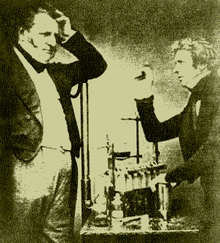This is a link to some short notes on this chapter.
Short Notes - Electrochemistry
Feel free to read them as you please.
About Us
Salam.
We are the students of Universiti Pendidikan Sultan Idris (UPSI), currently pursuing Master of Education (Chemistry). All of us are the members of Group 1 in "Technology and Innovation in Teaching and Learning Chemistry" (SKP 6024) course.
The members are:
Name: Ezrul Helmi bin Muhamad Razali
Matric No: M20122001486
Hometown: Sabak Bernam, Selangor
Place of Work: SMK Munshi Abdullah, Sungai Air Tawar, Selangor
Post: Chemistry Teacher
Name: Wan Mohd Faizal bin Wan Mohd Nasir
Matric No: M20122001521
Hometown: Slim River, Perak
Place of Work: SMK Pulau Ketam, Pelabuhan Klang, Selangor
Post: Chemistry Teacher
Name: Thanabalan A/L Munuswamy
Matric No: M20121000024
Hometown: Teluk Intan, Perak
Place of Work: SMK Sultan Abd Samad, Petaling Jaya, Selangor
Post: Chemistry Teacher
Name:Durairaj S/O Ehambron
Matric No: M20121000015
Home Town: Teluk Intan, Perak
Place of work: SJK(T) Ladang Escot
Post: Teacher
We are the students of Universiti Pendidikan Sultan Idris (UPSI), currently pursuing Master of Education (Chemistry). All of us are the members of Group 1 in "Technology and Innovation in Teaching and Learning Chemistry" (SKP 6024) course.
The members are:
Name: Ezrul Helmi bin Muhamad Razali
Matric No: M20122001486
Hometown: Sabak Bernam, Selangor
Place of Work: SMK Munshi Abdullah, Sungai Air Tawar, Selangor
Post: Chemistry Teacher
Matric No: M20122001521
Hometown: Slim River, Perak
Place of Work: SMK Pulau Ketam, Pelabuhan Klang, Selangor
Post: Chemistry Teacher
Name: Thanabalan A/L Munuswamy
Matric No: M20121000024
Hometown: Teluk Intan, Perak
Place of Work: SMK Sultan Abd Samad, Petaling Jaya, Selangor
Post: Chemistry Teacher
Name:Durairaj S/O Ehambron
Matric No: M20121000015
Home Town: Teluk Intan, Perak
Place of work: SJK(T) Ladang Escot
Post: Teacher
Introduction
This website is about the contents in the Electrochemistry topic, which is the sixth chapter in Form 4 syllabus.
Purpose: To provide a free online learning resources for everyone, especially for those Chemistry fans worldwide.

English chemist John Daniell (left) and physicist Michael Faraday (right), both credited as founders of electrochemistry today.
Electrochemistry is a branch of chemistry that studies chemical reactions which take place in a solution at the interface of an electron conductor (the electrode: a metal or asemiconductor) and an ionic conductor (the electrolyte). These reactions involve electron transfer between the electrode and the electrolyte or species in solution.
If a chemical reaction is driven by an externally applied voltage, as in electrolysis, or if a voltage is created by a chemical reaction as in a battery, it is an electrochemical reaction. In contrast, chemical reactions where electrons are transferred between molecules are called oxidation/reduction (redox) reactions. In general, electrochemistry deals with situations where oxidation and reduction reactions are separated in space or time, connected by an external electric circuit.
Subscribe to:
Comments (Atom)


.jpg)
.jpg)



